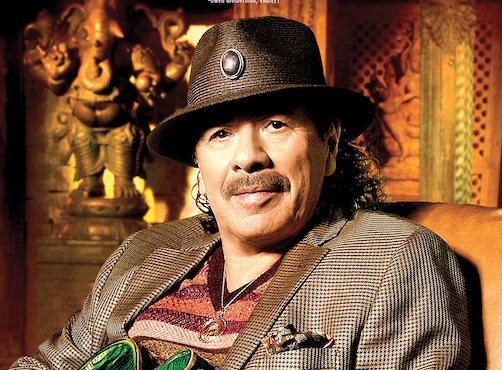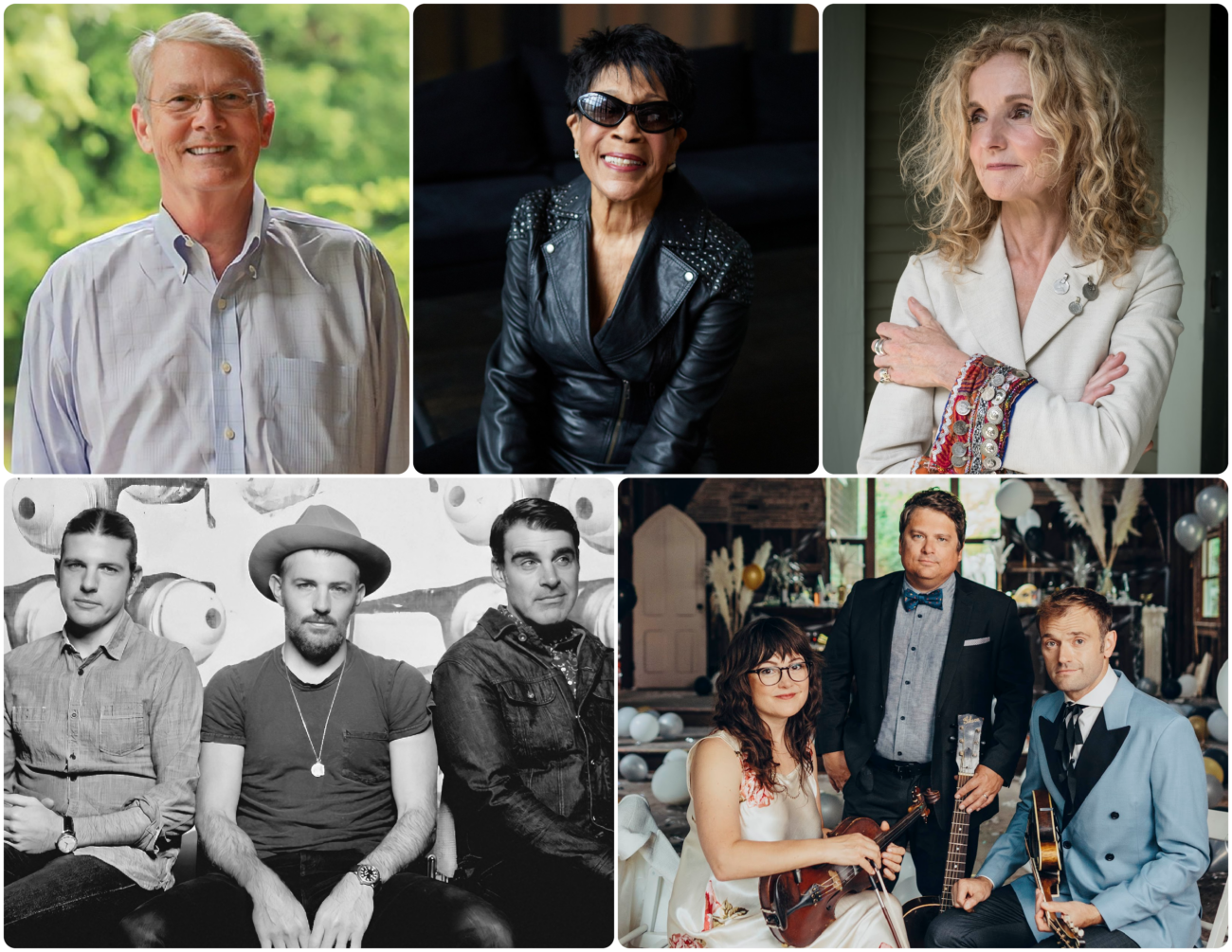A new feature-length documentary film chronicling the life story and work of guitarist and bandleader Carlos Santana, Carlos, will launch in theaters next month with a three-day premiere event. On Sept, 23, 24 and 27 only, screenings will include the documentary plus exclusive introductory content featuring Santana and two-time Emmy-winning director Rudy Valdez. Following the screenings, Carlos’ general theatrical release begins Sept. 29.
Having premiered earlier this year at the Tribeca Festival, Carlos combines new interviews with Santana and his family; never-before-seen archival footage, including home videos recorded by Santana himself; concert footage; behind-the-scenes moments; interviews with music industry collaborators, such as Clive Davis and Rob Thomas and more.
Tickets for Carlos: The Santana Journey Global Premiere went on sale beginning Aug. 24th. The film is presented in select cinemas worldwide by Trafalgar Releasing and Sony Pictures Classics.
For more than four decades—from Carlos Santana’s earliest days as a groundbreaking Afro-Latin-blues-rock fusion outfit in San Francisco—he has been the visionary force behind artistry that transcends musical genres and generational, cultural and geographical boundaries.
Santana arrived in the era-defining late 1960s San Francisco Bay Area music scene with historic shows at the Fillmore and other storied venues. The group emerged onto the global stage with an epic set at the Woodstock festival in 1969, the same year that its self-titled debut LP Santana came out. Introducing Santana’s first Top 10 hit, “Evil Ways,” the disc stayed on Billboard’s album chart for two years and was soon followed by two more classics — and Billboard #1 albums — Abraxas and Santana III.
More than 40 years and almost as many albums later, Santana has sold more than 100 million records and reached more than 100 million fans at concerts worldwide.
Santana has won 10 GRAMMY® Awards, including a record-tying nine for a single project, 1999’s Supernatural (including Album of the Year and Record of the Year for “Smooth”) and three Latin GRAMMY ® Awards. In 1998, the group was ushered into the Rock and Roll Hall of Fame.
Among many other honors, Carlos Santana received Billboard Latin Music Awards’ 2009 Lifetime Achievement honor, and he was bestowed Billboard’s Century Award in 1996.
On December 8, 2013, Carlos was the recipient of the 2013 Kennedy Center Honors Award.
The arc of Santana’s performing and recording career is complemented by a lifelong devotion to social activism and humanitarian causes. The Milagro Foundation, originally established by Carlos Santana and his family in 1998, has granted more than five million dollars to non-profit programs supporting underserved children and youth in the areas of arts, education and health. Milagro means “miracle,” and the image of children as divine miracles of light and hope—gifts to our lives—is the inspiration behind its name.
Carlos Santana was born in Mexico. He lives in Las Vegas, Nevada.
During 1976 and 2017 I interviewed Carlos. Portions of our conversations have been displayed from these two different encounters:
You’ve recently written your autobiography The Universal Tone: Bringing My Story To Light published by Little, Brown and Company. USA Today reviewed the book as “The most musically generous of the fall’s memoirs.” You collaborated with Ashley Kahn and Hal Miller on the endeavor.
“I wanted to share a story of how it can be done. I was at a picnic in San Jose many years ago. In one corner there is mariachi music and over at another place was Latin music, like Tito Puente, and another part was a band playing sort of blues and I’m hearing the whole sound at the same time. ‘Yeah! OK. I get it.’ Out of that picnic I walk away with, my favorite word, ‘we can crystalize all that you can imagine.’ I wanted to do songs that were slow and fast. God just gave me this mind.
“I wanted to honor my mother. She’s the one who rescued me from myself many times. I was destined to be dead already or be in jail in Tijuana if I would have stayed there.
“Here I am in Tijuana, watching this woman with tussles at a strip club. ‘Wow.’ It took a lot of talent to shake her body five different ways and walking through the drummers. In my book I wanted to tell the story in my book that the drummers in Tijuana are so close to the strippers and also the music. Strip joint music. To me, as a kid I was fascinated with the musical Maria. And in the strip joints it was the same thing.
“I remember poor adobe houses. I can’t remember ever being sad. I don’t think anyone denied me anything for too many years. I have always been in places and circumstances where people offered me a kit of things. Even in Tijuana, people offered me to play lead guitar rather than bass because they felt I had a feel for the guitar. The main thing is that I am grateful because out of a lot of people, I’m chosen to carry on a certain way of life, a certain way of manifesting music. A lot of people give me attention.
“Mi historia comienza con un desfile. My story starts with a parade. But really, we could start at any point in my life and that would be cool. It’s like the set list for a Santana concert. You could just rip it up, throw it up in the air, then put it back together. Anything you start or end with can work, really. It’s all the same circle, and it all connects.
“I have this good friend Hal Miller for a long time, and Ashley Kahn. The publisher made a suggestion of writers to help me. One was presented. ‘Absolutely not!’ I said no to a lot of things and wanted to go with Hal Miller and Ashley Kahn. They are going to milk stories from me wherever I will be. South America. France. Australia. I will bring them to different places. I have [manager] Michael and my sister to really be my editors and take the high road. This is not about gossip and getting even. If your name is not in my book I did you a favor. (laughs).
“Miles said to someone, ‘Not everything I write needs to be heard.’ I had a lot of help with my sister and Michael, who read everything. ‘Are you sure you want to go there?’ ‘OK. I don’t want to go there.’”
Your autobiography is candid and honest.
“I got in trouble when I said there are only two kinds of people. Artists and con artists. I really learned, with my sister and manager Michael to balance to take the high road. Look at the aerial view. See the big picture. Like with Arthur Ashe. Walk with grace and elegance.”
I really enjoyed the anecdotes and insights into your friendship and relationship with both Wayne Shorter and Miles Davis.
“I’m grateful to both of them. Wayne Shorter and Miles Davis. It’s the highest honor as a musician to be validated by Miles. He either liked you or didn’t like you. My phone would ring at 3:00 am and I would hear that voice. ‘What you doin’? Having fun? You’re always gonna be doing this.’
“It was gracious and complimentary to me as a person. One minute Miles could be Darth Vader and then the funniest. He was funnier than Richard Pryor when you hang around Miles. I loved saying that in my book. God loves characters. God loves all people but especially characters like Etta James, Minnesota Fats. Characters is another word for Divine Rascals. Who just about get away with everything. I’ve asked Wayne and Miles questions people would never dream about.”
Bill Graham is a recurring character in your book and he managed you for many years before his death in 1992.
“Bill Graham is still present in my life every day. I make decisions thinking of him. Of course. I call it ‘putting on the Bill Graham hat.’ When it comes to merchandising, t-shirts, bookings. There is symmetry to sound, colors and what we call merchandising. I’m really grateful to him. I did learn not to say, ‘I’m just a guitar player and don’t have to think about that.’ Copyrights, masters. That’s what I learned from Bill Graham: How to mind the store. Don’t look the other way. It’s your store. If you go broke it’s your fault. So, you need to monitor the people who are monitoring and maintain.”
Your book also describes the big impact FM radio had on you in 1967.
“It blew my mind when I found it. They played the whole songs of Vanilla Fudge, Country Joe & The Fish, the long version of Traffic’s ‘Smiling Phases,’ the long version of ‘Light My Fire.’ ‘Wow. This is really, really cool.’ Taking LSD and listening to Frank Zappa. Listening to the news. They had a guy [Scoop Nisker] who would report the news and say, ‘That was the news today. If you don’t like it go out and make it yourself.’
“For me, being right out of high school, and listening. And really listening, it gave me a vast awareness of ‘where do I belong in all this?’And I looked at B.B. King on my left and Tito Puente on my right. And that was a peak on acid when I saw this. ‘You can do both. You can be both.’
“The only thing the Santana band never wanted to do was succumb to phony. We were watching what was all unfolding with Sly Stone and Jim Morrison and it was becoming too much for all of them. “Becoming victims of an avalanche of illusion by not being prepared mentality to not deal with mass quantity adulation. I’m not dependent or addicted to mass adulation. That stuff makes me feel uncomfortable. I’m not afraid of it. I have learned to balance it.”
A big leap was made with Caravanserai your fourth album issued in October 1972. It was a big departure sound-wise from your first three LP’s. Lots of instrumentals and no hit singles.
There were also changes in band personal. It was the last Santana album to spotlight Gregg Rolie and Neal Schon.
“The music shift really surprised a lot of people, including my mom. ‘What are you doing? You’ve got the keys to every room.’ Everybody thought we should just duplicate Abraxis over and over. And I said, ‘No. That was then. We need to move forward.’ Even though it’s dangerous as everybody is saying it’s dangerous. ‘There’s no singles in here. There’s no this or that.’
“After a while when the dust settled, it was just Michael Shrieve and I. Because at the time, Greg and Neil wanted to go a certain way and that’s Journey. I didn’t want to go that way musically. With all respect to Journey. I want to hang out with people like Wayne Shorter and people to me who are like oceans. And I don’t want to be afraid of the wave.”
August 21, 1976 issue of Melody Maker.
C 2017 Harvey Kubernik
Kubernik: Reflect on music.
Santana: Being so young at the time and so fresh, we had a lot of conviction. We wanted to almost prove that we had something to say. When I first saw all that energy coming at me, I said if I don’t turn myself into a mirror reflecting it back, I’m in trouble.
To me, the real practicality is that some people are chosen instruments to carve a certain message, a certain mood, whatever. There are good musicians on stage but terrible people offstage. A good musician is a wonderful person onstage and offstage. He passes the ball like Pele; like Jerry. You take a solo, play a few bars, and give it to somebody else. When you are a musician of this caliber you will always remain. You have that awareness. The thing about concerts and musicians is, when you’re onstage you receive a lot of energy. A lot of times the energy is of gratitude, saying thank you for coming to our town and really doing it to me. Sometimes you find people who are harboring jealously or some kind of thing toward you, because maybe they’re seeing how much their ol’ ladies are captivated by your soul music. And they throw these things at you. I’ve seen musicians get so callous; when you receive a vibration you begin to get layers. You begin to be very insensitive. That’s the worst thing that can happen to a musician. The solution for some of the concerts is to clean ourselves. I found for me it is to walk in the woods or on the beach meditating by myself. You throw away all the impurities the people throw at you.
Let us discuss the Grateful Dead? Whose approach to spiritual matters, drugs and so forth is different from yours in 1976.
Santana: There are different levels of spirituality. The Grateful Dead give a lot of joy and spirituality to a certain amount of people. They don’t care so much for the white clothes, the incense and candles or the philosophy from India. I love the levels of playing with bands, because more people become aware of it. Chances are the Grateful Dead audience and the Santana audience will merge together and both learn from each other. When we played recently in Anaheim with the Beach Boys and America, I think the first ten minutes there was a total clash between our music and their people. They take downers, Quaaludes, wine, smoke. They’re so programmed to receiving a certain kind of loose music. Here we come out with this energy, pure energy, and it has to clash. It’s like living in a dark room for a long time and they put a flashlight in your eyes. It has to clash. For a while, the first 15 minutes is depressing. I’ve seen a lot of the people who leave the concerts, come in with their eyes red from just smoking a joint, and it’s good for them, but when they leave the concert they’re high with another kind of energy. Their eyes are clear because this energy is like water.
Q: Were you tough with the members of the initial Santana bands about how they conduct their lifestyles?
Santana: No. If you want something you don’t have to scream for it, all you have to do is long for it, like a baby crying for food. Someone comes to feed you. That’s how the musicians came to the band. They come to the band because they identify with the same thing that I need.
Q: Do you think drug use harmed the original line-up?
Santana: I don’t think drugs, or, money power or lust power for women did it. I think what did it was lack of discipline, because all those things are steps. I’m not saying they are bad or good steps. You take them as they cine, to get to a higher place. What destroyed the other band was the main thing that destroyed the Beatles, lack of direction, lack of having a goal, lack of that conviction. You all say, ‘man, we’re gonna be the best. Set up a target’ And all you do is concentrate on it and get it. Once you hit that target you have to get another target. That’s what mainly happened to the other band. People started over-indulging on everything.
Q: You are financially secure. Tell me about the barrio.
Santana: I remember poor adobe houses. I can’t remember ever being sad. I don’t think anyone denied me anything for too many years. I have always been in places and circumstances where people offered me a kit if things. Even in Tijuana, people offered me to play lead guitar rather than bass because they felt I had a feel for the guitar. The main thing is that I am grateful because out of a lot of people, I’m chosen to carry on a certain way of life, a certain way of manifesting music. A lot of people give me attention.
(Harvey Kubernik is the author of 20 books, including 2009’s Canyon Of Dreams: The Magic And The Music Of Laurel Canyon and 2014’s Turn Up The Radio! Rock, Pop and Roll In Los Angeles 1956-1972.
Sterling/Barnes and Noble in 2018 published Harvey and Kenneth Kubernik’s The Story Of The Band: From Big Pink To The Last Waltz. In2021 they wrote Jimi Hendrix: Voodoo Child for Sterling/Barnes and Noble. For 2024, the duo is working on a book for Insight Editions, Images That Rocked the World (The Music Photography of Ed Caraeff.)
Otherworld Cottage Industries in 2020 published Harvey’s Docs That Rock, Music That Matters.
On October 16, 2023, ACC ART BOOKS LTD is publishing THE ROLLING STONES: ICONS. 312 pages. $75.00. Introduction is penned by Harvey Kubernik. Spanning six decades, countless tours and album covers, this portfolio features imagery from some of the most eminent names in photography, alongside the photographers’ own memories and reflections. Includes photographs by Terry O’Neill, Gered Mankowitz, Linda McCartney, Ed Caraeff, Ken Regan, Douglas Kirkland, Dominque Tarle and founding member, bassist and photographer, Bill Wyman. Each photographer has selected images for their chapter and written an introductory text about working with the band.
Harvey Kubernik’s writings are in several book anthologies. Most notably, The Rolling Stone Book Of The Beats and Drinking With Bukowski. Harvey wrote the liner notes to the CD re-releases of Carole King’s Tapestry, The Essential Carole King, Allen Ginsberg’s Kaddish, Elvis Presley The ’68 Comeback Special, The Ramones’ End of the Century and Big Brother & the Holding Company Captured Live at The Monterey International Pop Festival.
During 2006 Kubernik spoke at the special hearings initiated by The Library of Congress held in Hollywood, California, discussing archiving practices and audiotape preservation. In 2017 Harvey appeared at the Rock and Roll Hall of Fame in Cleveland, Ohio, as part of their Distinguished Speakers Series.
During 2023, Harvey Kubernik was filmed by French director France Swimberge for her Mamas & Papas documentary. Broadcast scheduled on the European arts television channel, Arte. Kubernik is the film consultant.
Kubernik was an interview subject for director Matt O’Casey in 2019 on his BBC4-TV digital arts channel Christine McVie, Fleetwood Mac’s Songbird. The cast includes Christine McVie, Stan Webb of Chicken Shack, Mick Fleetwood, Stevie Nicks, John McVie, Christine’s family members, Heart’s Nancy Wilson, Mike Campbell, and Neil Finn.
Harvey was lensed for the 2013 BBC-TV documentary on Bobby Womack Across 110th Street, directed by James Meycock. Bobby Womack, Ronnie Wood from the Rolling Stones, Regina Womack, Damon Albarn of Blur/the Gorillaz, and Antonio Vargas are spotlighted. •














